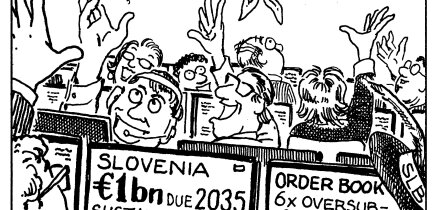Valuing options on a fixed exchange rate, or on any asset price set by official decree, is problematic. To the casual observer, such options may seem illogical, since the cash rate does not move. Yet active markets have existed on such options despite explicitly pegged exchange rate regimes. Exchange rate crises in which currency pegs were abandoned, such as Mexico (1994), Russia (1998), Brazil (1999), and Argentina (2002) have also shown that options with strikes outside the band are not worthless. Such options can offer valuable information about the probability of a peg holding over a given period. Following is a basis for pricing and evaluating such options using practical methods, and some simple estimation techniques for relative valuation.
Brownian motion is a reasonable approximation for the behavior of a broad range of financial asset prices. Consequently, the Black-Scholes application of Brownian motion to options pricing has become a widely-used yardstick, allowing traders to express prices in terms of implied volatility rather than premium, and providing a benchmark for institutions to value non-tradable assets with embedded options. But not all asset prices move in a random walk: some governments fix the external value of their currencies. Such policies have historically been employed with the aim of promoting trade or reducing inflation.
Historical volatility is generally a rough proxy for implied volatility. But implied volatilities of pegged currencies are generally much higher than the historical volatilities of their forward rates because the market estimates that the underlying distribution of returns is not normal, unlike the observed distribution of returns--which is roughly normal. The underlying distribution includes all possible events, as opposed to the observed distribution, which represents only the events that actually occurred over the period of observation. The underlying distribution for the Argentine peso prior to devaluation can be approximated as bi-modal, as shown in the following graph of the spot rate at maturity.
As long as the peg holds, the spot rate remains at parity. If the spot rate ever varies much, the act of abandoning the peg itself implies a loss of confidence, reviving fears of Argentina's former hyperinflation. Prior to devaluation, the currency was thought to be overvalued some 20-30% on a purchasing power parity basis, further shifting the balance of risk toward devaluation rather than revaluation. Because devaluation would be so potentially destructive, considering that much of the country's debt--both domestic and foreign--is denominated in U.S. dollars, the authorities were likely to strongly resist devaluation, as in fact they did. This implies that if a devaluation occurred, it would be sudden and large, with virtually no prices observed between the two modes, as was essentially the case.
One might consider pricing options on a bi-modally distributed asset using a model incorporating two distributions, each with its own standard deviation, or via a Merton-type jump-diffusion model. But the guesswork of estimating parameters for the right-tail distribution makes such models impractical. A more useful method is to express the ratio of the right tail relative to the whole distribution via a single probability, allowing one to price options with strikes between the two modes. This provides a simple estimate for a large region where the option price behaves linearly. Under this assumption, the option price reflects information about the currency's underlying probability distribution, allowing one to infer both the probability and expected magnitude of devaluation.
To calculate the probability, assume a spot rate of ARS1, a dollar deposit rate of 6%, and a one-year forward rate of ARS1.05, (implying a peso deposit rate of 11.2%), and suppose the at-the-money forward (ATMF) call on the peso trades at a premium of 4.16% of the dollar (equal to an implied volatility of 11.0%). If there is no change in the peg, the option buyer has an expected profit of [(1.05/1.00)-1] x [(1/(1+.06)] = 4.71%. In present value terms, the call option buyer risks 4.16% to make 4.71%, implying a no-devaluation probability of (4.16 / 4.71) = 88.3%. The devaluation probability is therefore (100.0% - 88.3%) = 11.7%.
The expected magnitude of a devaluation can be derived from the price of the ATMF put on the currency, since the buyer of the put has an expected profit corresponding to the devaluation probability and the cost of the option. The put buyer risks 4.16% to make an uncertain profit. The present value of the buyer's expected profit is thus (premium / devaluation probability) = (4.16% / 11.7%)= 35.6%. This corresponds to a spot rate of [strike/(1devaluation magnitude)] = [1.0500 / (1-35.6%)] = 1.6304.
A short position in the naked ATMF call on the peso makes a profit (equal to the premium) if the peso devalues beyond the forward prior to expiration. The present value of the forward points multiplied by the probability of no devaluation is thus a first approximation for the price of the peso call. This assumes that the probability of revaluation is zero. In practice, the peso call with a strike of ARS1.00 did not trade for zero premium, since there were potential scenarios in which the currency could revalue. Prior to devaluation, the price of the one-year ARS1.00 call typically ranged from 0.15% to 0.30% of the dollar. This option was frequently quoted and its price easily observed.
This probability can be incorporated into a pricing formula by simply specifying a price for the ARS1.00 call. We can also generalize the formula for all strikes above ARS1.00 and below the region of the right tail:
The difference in price between the peso call for a given strike (Pstrike ) and the peso call with a strike of one, relative to the value of the spread, should be equal to the probability of no devaluation over the period of the option.
For example, to price a one-year dollar call/peso put with a strike of ARS1.1500, assume the one-year ARS1.00 peso call is 0.20%, the annual probability of devaluation is 25%, the one-year forward is ARS1.0800, and the one-year dollar deposit rate is 5%. The value of the peso call is 0.20%+(1-25%)x(1.15/1.00-1)x[1/(1+5%)]=10.91%, implying a volatility of 19.0%. By put-call parity, the peso put is worth 10.91%-(1.15/1.08-1)x[1/(1+5%)]=4.74%.
This technique generates a volatility smile much in line with observed market prices, and prices strikes up to the region of the right-tail distribution. Beyond this level, the technique begins implying negative option prices and cannot be used, since it assumes no knowledge of the shape of this part of the distribution. However, observed market interest in such high strikes relative to the level of forwards in the case of the Argentine peso was rare.
A careful analysis of a fixed asset's underlying distribution, taking into account relevant macroeconomic and policy-related drivers, can assist the trader or analyst in pricing derivatives on such assets. Such option prices can be expressed in terms of two intuitive factors: annualized probabilities of devaluation and values of at-the-money-spot calls. The simple model suggested here is not intended to predict option prices, though it does aim to provide a basis for relative valuation. Instead, it provides a benchmark which, like implied volatility, can be more intuitively discussed to formulate option prices. Using this methodology, six-month options traded in September 2001 in the brokered interbank market--some of the last options traded prior to the devaluation of January 2002--priced in an annualized probability of devaluation of approximately 70%, with an expected devaluation magnitude of around ARS2.10, very indicative of the actual event.
This week's Learning Curve was written byJames Kennan, v.p. atBNP Paribas in New York.





